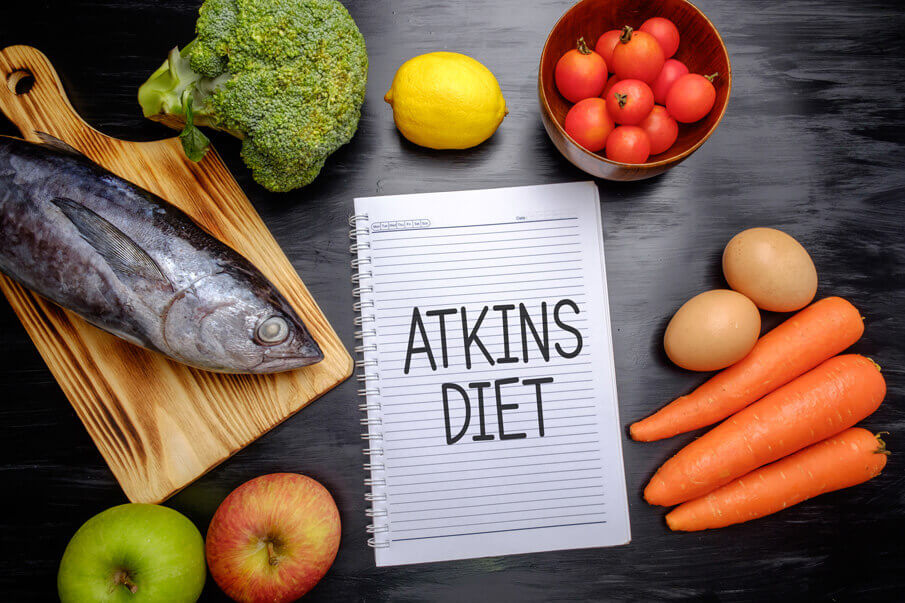
ATKINS DIET: POSSIBILITIES AND RISKS
Reading time: 03:47 minutes
Table of contents
- What is the Atkins diet?
- The principles of the Atkins diet
- The four phases of ketosis
- Risks of the Atkins diet
1. WHAT IS THE ATKINS DIET?
Robert Atkins was born in Ohio in 1930 and concentrated on cardiology after completing his medical studies. He was always looking for alternative therapeutic approaches. Atkins himself suffered from severe obesity - this motivated him to develop a scientifically based diet that would allow people to lose weight quickly without starving themselves. He presented his diet revolution to the public in 1972.
It was based on largely eliminating carbohydrates from the diet and relying mainly on protein and fats for energy. The Atkins diet caused quite a stir. The doctor became increasingly involved in researching carbohydrates as a nutritionist, wrote many books and founded his own food company in addition to his Atkins Research Center.
2. THE PRINCIPLES OF THE ATKINS DIET
The Atkins diet is known for its ability to achieve noticeable results quickly - without starving yourself or laboriously counting calories. The secret is a change in metabolism. The body can no longer generate its energy from carbohydrates due to the choice of food. It therefore first burns its carbohydrate reserves and thus empties the glycogen stores in the muscles. Glycogen binds water in the body, which is why a lot of water is excreted in the initial phase of the Atkins diet. This means that you lose a lot of weight right from the start.
After a certain time, the metabolism changes: instead of carbohydrates, the body uses stored fats and the fats from the food you eat as a source of energy. However, it must first metabolize these fats in the liver into so-called ketone bodies - the three acids acetoacetate, acetone and beta-hydroxybutyric acid - before it can use them. The metabolic state in which the body forms ketone bodies is called ketosis. Ketone bodies are considered an effective source of energy.
To get into ketosis, the diet should be low in carbohydrates but high in protein and fat. For example, green vegetables such as lettuce, broccoli, zucchinis and spinach are low in carbohydrates. In addition, foods high in protein - such as meat, poultry, fish, seafood and eggs - are supplemented by sources of fat such as oils and cheese.
3. THE FOUR PHASES OF THE ATKINS DIET
A typical Atkins diet consists of four phases. A certain amount of carbohydrates is consumed in each phase.
First phase - Introduction: In the first two weeks of the Atkins diet, the metabolism is to be switched so that ketosis begins. For this purpose, only 20 grams of carbohydrates may be consumed per day. Salad and vegetables should be the source of these carbohydrates; bread, cereal products and potatoes should be completely avoided. The main components of the diet are meat, eggs and soy products.
Second phase - reduction: In the second phase of the Atkins diet, the aim is to lose as much weight as possible. Initially, the amount of carbohydrates per week can be increased by five grams. Instead, nutrient-rich foods such as berries, nuts, seeds and pulses are now on the menu. As soon as the body stops losing weight, the amount of carbohydrates should be reduced again by five grams. For most people, this is between 40 and 60 grams.
Third phase - pre-maintenance: Now the target weight is slowly within reach. The amount of carbohydrates is increased by 10 grams per week - until you stop losing weight.
Fourth phase - maintenance diet: The aim of the maintenance diet is no longer to lose weight, but to keep it off. According to Robert Atkins, this phase should be maintained for life. The body is no longer in ketosis, but continues to receive relatively few carbohydrates. Accordingly, the foods are also more varied: in addition to vegetables and salads, meat, fish, fruit and nuts are also consumed - bread, cereal products and potatoes should be eaten sparingly.
4. RISKS OF THE ATKINS DIET
The Atkins diet has been controversial since its invention. Nutritionists and doctors see the danger of malnutrition, hyperacidity of the body, which could lead to gout, a strain on the kidneys due to too much protein and the development of cardiovascular diseases due to high blood fat levels. However, studies have not yet been able to prove that these fears are realized in practice1. However, studies have shown that the Atkins diet leads to weight loss success more quickly than a diet that focuses on reducing fat2.
However, doctors point out that an Atkins diet should be carried out under medical supervision. People who want to lose weight must make sure they drink plenty of water to flush the ketone bodies out of the body and prevent acidosis. They should also take nutritional supplements to prevent an undersupply of important vitamins, minerals and trace elements.
CONCLUSION
The Atkins diet is an effective nutritional program for losing a lot of weight quickly - this is also confirmed by scientific studies. However, there are also health risks involved. In order to lose weight healthily, a doctor should supervise the diet, and care should be taken to ensure sufficient fluid intake and a nutrient supply with food supplements.
Sources:
1 Study: Linda Stern et al. The Effects of Low-Carbohydrate versus Conventional Weight Loss Diets in Severely Obese Adults: One-Year Follow-up of a Randomized Trial, Link: https: //pubmed.ncbi.nlm.nih.gov/15148064/
2 Study: S. Jasni et al. Effectiveness of the Atkins Diet as a Treatment of Weight Reduction, Link: https: //www.semanticscholar.org/paper/Effectiveness-of-the-Atkins-Diet-as-a-Treatment-of-Jasni-Osman/98f7f5a9183cbba63ebf0d17ff5ce43e0a57c9c7
